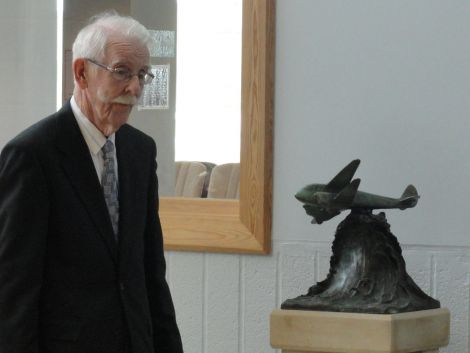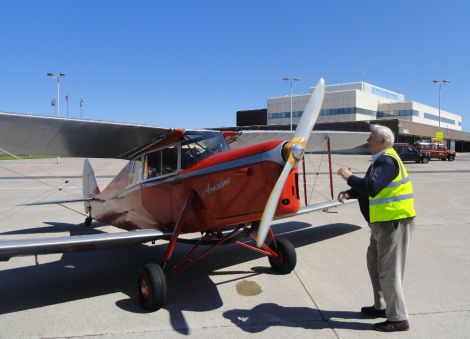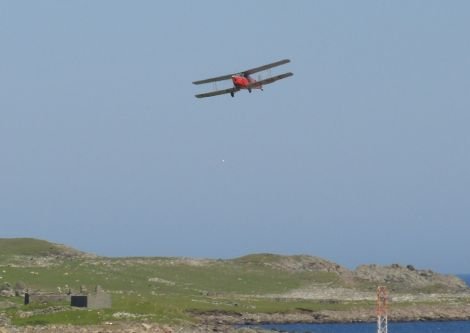News / Sumburgh airport celebrates 75 years of business
THE ARRIVAL of a 1936 de Havilland Hornet Moth aircraft was one of the highlights of the celebrations to mark Sumburgh airport’s 75th birthday, on Friday.
The presence of the immaculately kept red bi-plane, flown by enthusiasts Capt Mark Preston and Dick Felix, from Devon, added an extra dimension to Friday’s memorial unveiling ceremony to commemorate the achievements of aviation pioneer Ernest Edmund Fresson.
Capt Fresson made the first scheduled flight between Aberdeen and Shetland on 3 June 1936, after having completed a number of charter flights to the isles in the preceding years.
Following two speeches by council convener Sandy Cluness and the chairman of the Fresson Trust, Grenville Johnston, it was the honour of former airport manager Jimmy Burgess, also referred to as Mr Sumburgh Airport, to unveil the memorial.
Mr Burgess (86) started working at the airport as a young boy back in 1939 and retired as its manager in 1990.
As one of only a few people left who still remember Capt Fresson, he said: “He was a hard businessman and a good pilot. You had to be in the days gone by – but a fair man to work with”
He added that in the early years the airport was run from a few huts with a grass runway grazed by sheep and cattle when not planes were about.
Grenville Johnston, who is also the chairman of Highlands and Islands Airports Limited (HIAL), said the bravery and skill of Capt Fresson and the other aviation pioneers could not be praised enough.
He said that at that time pilots effectively flew into the unknown with no radar or radio cover.
Capt Fresson had first reached Shetland as early as early as 1933 when he took up some charter passengers on business, landing at the Sumburgh Links, the first piece of flat ground when reaching the isles from the south.
Become a member of Shetland News
Mr Johnston said: “It was an historic time for communication. He could fly up here in a few hours, deliver passengers and then go down back again. He could deliver the mail, you could get the Press and Journal on the same day, and things like that simply transformed life on the islands of Scotland.
With the arrival of North Sea oil in the seventies, Sumburgh Airport was in for further dramatic change.
The large Wilsness Terminal was completed in 1978 to manage the transfer of thousands of oil workers to and from the ever increasing number of oil installations in the northern North Sea.
Passenger throughput rose to as much as one million per year, an astonishing figure for a small island community of just 22,000.
Today most of the oil related business has moved on, but Sumburgh Airport remains one of the busiest among the 10 airport under the Highlands and Islands Airports umbrella, dealing mainly with domestic flights operated by Loganair/Flybe. The airport also the base for the Shetland based coastguard search and rescue helicopter.
Airport manager Nigel Flaws said that given that Shetland was the Scottish islands most dependent on air services, it was vital to continue improving the service.
“The focus of our work is to continue developing the domestic service because that is for the people of Shetland and also the people who want to visit Shetland.
“Along with that we look at continuing to support the oil industry and hopefully as there is more work to the West of Shetland developments and with decommissioning, we hope to win some business and support the helicopter operators with their fixed wing coming in here.”
Become a member of Shetland News
Shetland News is asking its many readers to consider paying for membership to get additional features and services: -
- Remove non-local ads;
- Bookmark posts to read later;
- Exclusive curated weekly newsletter;
- Hide membership messages;
- Comments open for discussion.
If you appreciate what we do and feel strongly about impartial local journalism, then please become a member of Shetland News by either making a single payment, or setting up a monthly, quarterly or yearly subscription.




























































